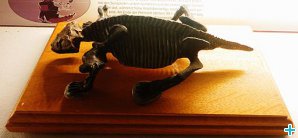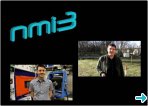Looking millions of years back with neutrons: the hearing of the Kawingasaurus fossilis
A study with neutrons suggests the K. fossilis could hear through bone conduction and seismic vibration.
Inês Crespo, Information Manager, 28/10/2014
Let’s travel back in time and imagine how life on earth was before the biggest mass extinction on Earth, about 252 million years ago. The Kawingasaurus fossilis was a small herbivorous living in the Late Permian period. By using neutrons, a scientist investigated the mechanisms through which the K. fossilis could hear.
Nowack found the fossils of this species in Tanzania in 1936. They now belong to the Paleontological Museum in Tübingen, Germany, making it one of the most important and complete collections worldwide. Thanks to the NMI3 Access Programme , Michael Laaß from the Ruprecht-Karls-University of Heidelberg in Germany could conduct experiments at the Paul Scherrer Institute in Switzerland to analyse the fossils. Neutron tomography and 3D visualisation made it possible to look at the internal cranial anatomy of the K. fossilis and infer on its hearing.

Left: photo of K. fossilis skull; Right: 3D-reconstruction on the basis of neutron tomographic data (courtesy of the author)
The investigation revealed that the K. fossilis had much bigger inner ears than any other mammal (except from the Lambdopsalis from the Cretaceous). Even though the K. fossilis had only a skull length of circa 40mm, which is less than a third of the human skull, the ear vestibule had a volume about 25 times larger than that of humans.
Such extraordinary dimensions suggest that the K. fossilis could hear mainly through bone conduction and seismic sensitivity. Bone conduction is the process that conducts the sound to the inner ear through the skull. This is how we hear ourselves speaking and also how we listen to music with some types of headsets.

The animal had a fused triangular head with a snout shaped like a spatula, probably used for digging. This feature also enhanced seismic signal detection, which is how a number of animals sense information such as warnings about predators, courtship or group maintenance, through seismic vibrations of the ground or other substrate. Once perceived, seismic vibrations are then transmitted by bone conduction to the inner ear.
This work makes us go back in time and imagine how these species behaved.
Original publication
Laaß, M. (2014), Bone-conduction hearing and seismic sensitivity of the late permian anomodont Kawingasaurus fossilis. J. Morphol.. doi: 10.1002/jmor.20325
NMI3 thanks Michael Laaß for reviewing this article.
Latest NMI3 highlights
Neutrons shed light on how to make pregnancy tests more sensitive and cheaper
Thanks to neutrons, scientists could investigate the interaction between antibody and antigens and the importance of a blocking protein, present in home pregnancy tests. Read it here .
Good results obtained with a novel technology to produce large-scale neutron converters
NMI3 supports a European collaboration to develop an atmospheric plasma deposition system to produce Boron-10 layers. You can watch our video and article !
New humidity chamber will shed light on processes behind Alzheimer’s disease
A JRA supported by NMI3 is working on a new humidity chamber. The instrument will be used for neutron scattering experiments to reproduce the human body conditions in order to shed light on biological processes such as the development of Alzheimer’s disease. Check out our video and article !





